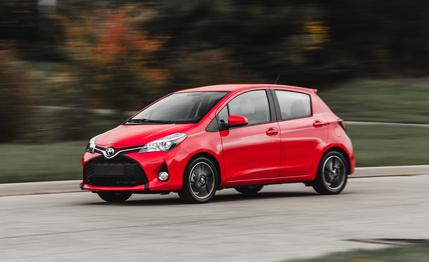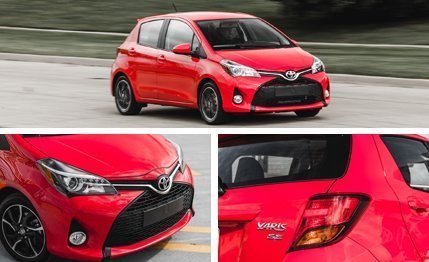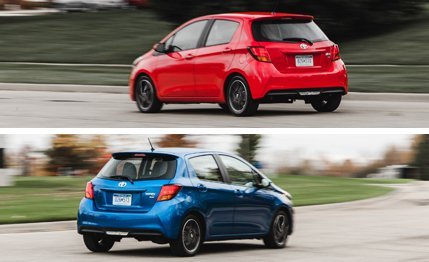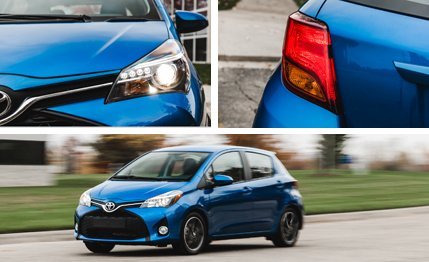
 Instrumented Test
Instrumented Test
The midcycle refresh is aimed at keeping a vehicle line on shopping lists until the next major makeover. It’s often confined to cosmetics, but there are times when the investment would be more effective upgrading elements of the car that are invisible but tangible.
Case in point: the 2015 Toyota Yaris. It does a fair impression of being a new car with more expressive styling, fresh taillights, a reshaped rear bumper, and a number of interior upgrades. But unchanged is the critical area in which the Yaris has trailed subcompact leaders like the Honda Fit, the Ford Fiesta, and the Chevrolet Sonic. That would be the powertrain. Toyota sends the refreshed model out with the same anemic long-stroke 1.5-liter four-cylinder that’s been banging around since 2000. It’s mated to the same five-speed manual, and the same four-speed automatic, that have served since the 2007 Yaris replaced the unloved Echo.
Compared with other engines offered in this class—say the Fit’s 130-hp 1.5-liter direct-injected four or the Fiesta’s 123-hp direct-injected three-cylinder turbo—the port-injected Toyota is distinctly behind the times. Straining to make 106 horsepower, it sounds industrial when pressed, which would be most of the time.


But the real anachronism is that four-speed self-shifter. It not only trails the segment’s automatics in forward speeds (we include the CVTs), its old-fashioned zig-zag shift gate also lacks a manual shift function.
If ever a transmission made the case to Save the Manuals, this is it, and to illustrate the advantage of shifting for yourself with this car, we took identical top-of-the-line Yaris SE models, an automatic and a manual, to the test track.
The data-panel numbers generally speak for themselves, with the manual holding a 1.3-second advantage on the sprint to 60 mph and maintaining a 0.9-second lead through the quarter-mile. We’ve grown used to the latest generation of automatics being able to match or beat manual-gearbox acceleration times, but this slushbox is hardly the latest generation. It was already a fossilized relic that generated complaints five years ago.
One asterisk: Data-divers will note that, although the manual smokes the automatic in most categories, it trails in top-gear acceleration from 30–50 and 50–70 mph. This is a function of our test procedure. In top gear, when the test driver tramps on the gas the automatic kicks down, whereas the manual is locked in fifth and the engine simply lugs. In real-world passing, the driver of the manual would snick down to a lower gear, revving the engine into the sweet part of its power band.


“Sweet” would be a relative expression in this case, but you get the point. “Snick down” similarly overstates this case. Operation of the Yaris’s five-speed shifter is acceptable, but it doesn’t measure up to the enjoyable sense of precision found in the Honda Fit’s six-speed manual.
EPA fuel-economy ratings are pretty much on par for the segment and there’s no real advantage to either transmission: We averaged 29 mpg with both.
Major powertrain upgrades are expensive, of course, so they rarely occur at a midcycle freshening. The Corolla, for instance, had to wait for last year’s all-new model before Toyota replaced its four-speed automatic with a CVT in all but the base trim. To its credit, though, Toyota’s investment in the Yaris does go deeper than the surfaces. Chassis improvements include additional spot welds to enhance body-shell rigidity. This selective stiffening and subtle suspension retuning add up to a Yaris that’s surprisingly responsive and quick on its feet.


Grip—0.80 g on the skidpad—is typical for this class, as is the braking performance, which is not a bragging point. These SE models were equipped with the 16-inch wheels and 195/50 tires that are the best offering from the factory, so if you want more grip, the aftermarket is the only solution.
On balance, this is an improved Yaris with better interior materials, added features (6.1-inch color touch screen, nav system), and excellent fit and finish as newly executed at an assembly plant in France. Driver comfort could be improved even more were the steering column made adjustable for reach as well as rake, but budgets are budgets.
The Yaris now looks modern inside and out, and it’s a bit more entertaining to drive. It’s not up to challenging the Fit and the Fiesta for driver satisfaction, though, and the imminent arrival of a new Mazda 2 threatens to further scramble the segment rankings. Fortunately for Toyota, Mazda’s program will also produce an all-new Yaris. In the meantime, this refresh at least gives the Yaris the looks of a contender. It’s more likely than its predecessor to make owners happy, provided they don’t opt for the automatic transmission.